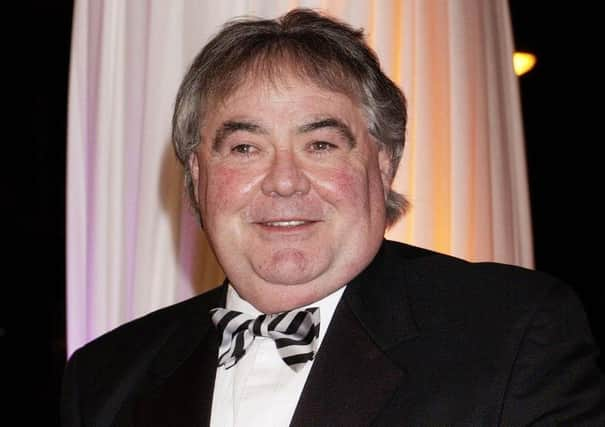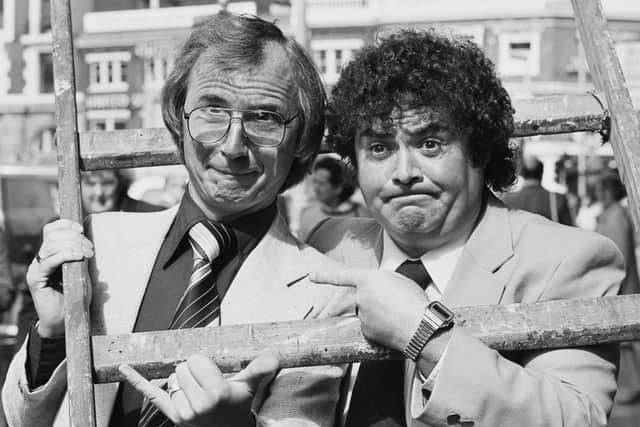Obituary: Eddie Large, Glasgow-born double act comedian who shot to fame on Opportunity Knocks


Syd Little and his Glasgow-born partner Eddie Large were having so little success as a comedy double act in working men’s clubs at the beginning of the 1970s that they almost gave up. Then they appeared on ITV’s hugely popular talent show Opportunity Knocks, a sort of forerunner of Britain’s Got Talent. The public took them to their hearts, voted them the winners and before long they were appearing with Bob Hope in front of royalty.
In winning Opportunity Knocks, they were following the likes of Les Dawson, Freddie Starr and Mary Hopkin. Suddenly they were stars. They appeared on the Royal Variety Show, they were lauded by the BBC as the natural successors to Morecambe and Wise and they attracted audiences of up to 16 million on their prime-time Saturday night show.
Advertisement
Hide AdAdvertisement
Hide AdThere were similarities to other successful double acts. Like Laurel and Hardy, one was somewhat large and the other rather more slender – Little and Large were not of course their real names. Like Morecambe and Wise, one – in this case Syd Little – was the straight guy, trying to be serious, while the other mucked about and undermined him with silly faces, silly props and general silliness.


It would be fair to say that not everyone thought they stood comparison with Laurel and Hardy or Morecambe and Wise, or that they were even very funny. Eddie Large clearly did. It always looked like he was having a great time, enthusiastically leading the laughter and, for a while, it was infectious. But the audience figures slipped, the BBC dumped them and they seemed to disappear as quickly as they had emerged. They went their separate ways and Syd Little even returned to his old trade as a painter.
The son of a sailor, serving as a petty officer in the Royal Navy, Eddie Large was born as Edward Hugh McGinnis in the old Rottenrow Hospital in Glasgow in 1941. As a baby he contracted diphtheria and was not expected to live. The family lived in the Gorbals. His father was Protestant and his mother Roman Catholic.
The family moved to Manchester when he was ten but Large retained vivid memories of sectarian violence in his home city. Large was baptised as Catholic, but went to a non-sectarian primary school. He recalled in his autobiography Larger than Life (2005) that all the children would play happily together, except on religious holidays.
Advertisement
Hide AdAdvertisement
Hide Ad“We would stop playing and start fighting, mimicking our elders… I saw young lads slashed with razors and others have their heads split open by bricks, all in the name of religion.” It put him off organised religion for life.
He went with his father to support Clyde FC, which he reckoned his father chose to avoid the sectarian bigotry that blighted Celtic and Rangers. Their new home in Manchester was opposite Manchester City’s ground and he became a keen fan.
Large trained as an electrician and began singing in pubs and clubs. One story has it that he met Cyril Mead, who would become his partner Syd Little, when Large knocked him down on a zebra crossing. He went to see if he was alright, they discovered they were both entertainers, struggling to make a go of it in local pubs and clubs, and decided to join forces.
A more likely story has it that McGinnis, as he was then, saw Mead singing in a Manchester pub and began heckling. This impromptu double act of the hesitant, nervous singer and the large, ebullient heckler proved more popular with the audience than the singing and became a central part of the act when they teamed up as Little and Large. That was in the early 1960s and while Opportunity Knocks made them an overnight success, it was on the back of a decade of slogging round pubs and clubs.
Advertisement
Hide AdAdvertisement
Hide AdOpportunity Knocks led to guest spots on various variety shows and regular appearances on Crackerjack and Who Do You Do in the first half of the 1970s, then The Little and Large Telly Show on ITV in 1976 and The Little and Large Show, which ran on BBC1 from 1977 to 1991.
With changing tastes in comedy, their popularity declined. Their act looked old-fashioned and tame at a time when a new, more daring generation of comedians was emerging from universities and into comedy venues. There were inevitable tensions in the pairing too, with Large very much the demanding perfectionist, despite the air of silliness. They continued to appear in theatres and clubs for a few years before splitting up.
In 2003, Large had a heart transplant, but he continued to struggle with various health issues. In an interview in 2010 he revealed that he had had not spoken to his former partner since before the operation. However, they did get back together for appearances on Ant and Dec’s Saturday Night Takeaway in 2018 and a charity celebrity edition of the quiz show Pointless last year.
Large’s first marriage did not survive his life on the road as an entertainer and the temptations that came with it. “Quasimodo could pull if he was in showbiz,” he said. He is survived by his second wife Patsy, who he married in 1983, and by three children.
BRIAN PENDREIGH